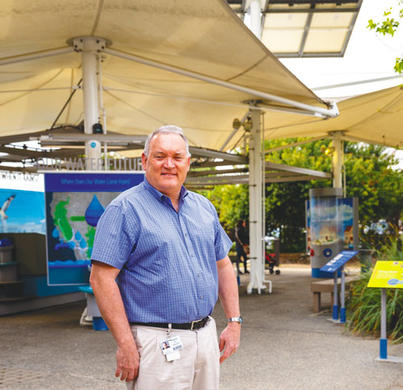Reducing plastic straws and bottles, installing plants that require little water and employing sustainable construction practices are some of the ways the Aquarium of the Pacific is conserving water, plastic and energy to maintain its status as an environmentally friendly facility.
“It has been a sustainable facility since it opened,” John Rouse, the Aquarium’s vice president of operations, said. He added that, “Back in 2004 or 2005, when energy costs went up dramatically, it was a catalyst for the Aquarium to work harder on [lowering] energy use.”

Vice President of Operations John Rouse is pictured in front of the “Our Water Future” exhibit, which educates guests on water conservation. Reducing water use is an ongoing project at the Aquarium. The goal is to maintain current water levels even though the facility is expanding, Rouse said. (Aquarium of the Pacific Photograph)
For 16 years, the Aquarium has used waterless urinals and dual-flush toilets, which Rouse estimated has saved 960,000 gallons of water every year. The facility’s 6,000 square feet of gardens also houses plants that require little water. The drip irrigation system ensures that minimal water is wasted, and an irrigation controller customizes the watering schedule based on the weather each day.
The Aquarium aims to impart the conservation message to visitors through its “Our Water Future” exhibit. A three-dimensional model of the Los Angeles and San Gabriel River watersheds simulates rain to teach visitors the path of water in the region once it exits the clouds. The exhibit educates on individual water-saving practices as well as how to maintain the supply of water needed in Southern California.
The SAVOR Watershed Classroom, located within the exhibit, serves as an example of sustainable architecture. The structure’s lights and ceiling fans are powered by solar energy. According to Rouse, the classroom is the first building in Long Beach to obtain a Leadership in Energy and Environmental Design (LEED) Platinum designation, which is LEED’s highest rating. Earning this worldwide green building accreditation requires fulfillment of about 45 environmental standards, Rouse said. These include features to conserve water and power as well as the use of recyclable construction materials.
Rouse said any energy-saving project “absolutely” saves the Aquarium money. “It’s a good motivator, along with the environment,” he explained.
The Aquarium has partnered with Southern California Edison on a number of initiatives. One of these projects is a chilled water loop that creates air conditioning for the tanks. According to Rouse, the Aquarium invested $100,000 into the project and received a $150,000 rebate.
“We’ve gotten rebates for our greening strategies to reduce our energy use, which has been flat for the past few years,” Rouse said. “Our energy cost for kilowatt hours [a unit of measure for energy use] has been flat over the last 10 years.”
The Aquarium also participates in Edison’s Demand Response Program, for which businesses reduce energy consumption on peak power usage days to relieve stress on the electricity grid. Rouse estimated that on these days, usually in the summer, the Aquarium cuts its energy use by about 200 kilowatts. For perspective, the average dishwasher uses 1.2 to 1.5 kilowatts every year and the average oven about 2.15 kw, according to Modernize Home Empowerment.
The Port of Long Beach has also invested in the Aquarium’s sustainability. About three years ago, the port granted the Aquarium approximately $300,000 to replace all of its boilers, which reduced greenhouse gas emissions, Rouse said.
The Aquarium of the Pacific is a member of the Aquarium Conservation Partnership, a national organization made up of 27 different institutions. Its current project is reducing plastic straws in the ocean, which is in line with the Aquarium’s goal to cut back on plastic bottles in its dining areas.
“By 2020, we’ll significantly reduce our 20-ounce drinks in plastic bottles and replace them with fountain drinks. Our cups are paper and compostable,” Rouse said.
Another future goal is to add fuel cells to the Aquarium. These provide another energy source by generating electricity through a chemical reaction. Rouse said the Aquarium’s new Pacific Visions wing, due to open next spring, will earn Green Globes for sustainable construction. Green Globes is an environmental building certification program used in Canada and the United States. It ranks buildings with “Green Globes” based on the number of sustainable practices incorporated.
“Our goal is to maintain current water levels even though we’re expanding by about 27,000 square feet,” Rouse said. “Our energy goal is to not add more energy usage to the grid.”
